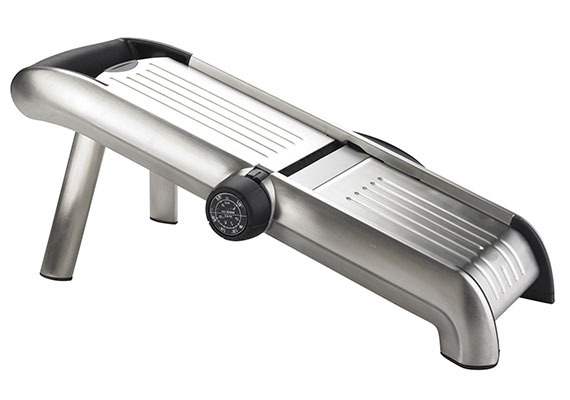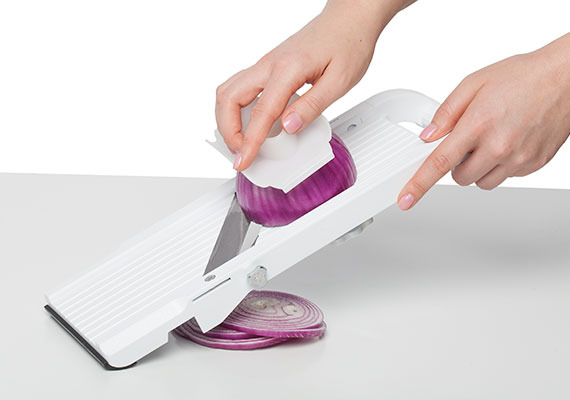The Best Mandoline Slicers 2017
We test and review the best mandoline kitchen slicers on the market to find our 5 favorites
One of the best ways to tell if someone is a serious home cook is whether or not they have a mandoline slicer in the kitchen. No other tool is as useful for making the quick, clean cuts required for everything from freshly shredded cole slaw to the perfect homemade potato chip.
Most mandolines have either an all-metal or a plastic frame with straight, V-shaped or diagonal stainless steel blades (the latter are best for softer, more fragile foods like tomatoes). Some even have fold-out legs that hold them upright or a container that collects the food. Most importantly, all mandolines come with a finger guard—some of which are easier to use than others. Regardless, you don't want to use your slicer without it (just ask any seasoned chef). If you really find using the guard awkward, invest in a cut-resistant glove.
RELATED This Is the Most Useful Tool Your Kitchen Is Missing "
To find the best of the best, we risk our fingertips and try an array of slicers at various price points to find the top in performance and design. To put the models to the test, we slice a variety of foods, from delicate tomatoes to hard sweet potatoes. We slice at various thicknesses and try out different slicing blades, keeping tabs on how comfortable and easy each one is to use.
① OXO SteeL Chef's Mandoline Slicer ($100)
Why We Like It: OXO has a number of different slicers, and this is the most well designed (and priciest) of any we tried, from OXO or any other brand. The slicer comes with two double-sided cutting blades: The primary blade has a straight edge and reverses to a finely serrated edge designed for softer foods, while the other blade can make either crinkle or ruffle cuts. They're easy to change as well—they slide in and out on the side, and a knob easily adjusts the thickness (anywhere from 1/16 to ⅜ of an inch) and also flips up the julienne blades. The straight edge cuts almost everything easily and cleanly, and most foods are also easy to julienne. The food holder is comfortable to grip, although it leaves a fairly big chunk of food behind that the blades can't reach.
The Drawbacks: Both white and sweet potatoes are nearly impossible to cut with the wide julienne blade. And though we like the little sheath that fits any blade not being used, we wish both blades could fit inside so that the slicer could be stored more safely.
② Cuisinart Mandoline ($80)
Why We Like It: Cuisinart's grande dame of mandolines is also one of the most versatile you can buy; the entire package includes a shredding, crinkle cut, and both fine and thick julienne blades that attach neatly to the body. The safety grip is one of the most effective and easiest to use; pinching the buttons on the sides slowly ejects food out of the guard as you slice, making it both the safest and least wasteful in operation (the box also includes a protective glove for extra-cautious cooks). A handy storage shield protects both the straight blade—and stray fingers—while the mandoline is sitting in storage.
The Drawbacks: For what's supposed to be a simple slicing tool, the oversize plastic body requires a dedicated shelf in your cupboard. Numerous knobs and adjustments mean there's a bit of a learning curve, and it takes a while to apply the right amount of pressure, so thicker slices don't turn out lopsided. Forcing potatoes through the julienne dye also needs an almost-scary amount of force.
③ Benriner Japanese Mandoline Slicer ($65)
Why We Like It: This Japanese slicer is considerably cheaper than both the OXO and Cuisinart, but for simple slicing tasks, it's just as effective. It comes with three toothed blades for making various widths of julienned cuts that are slipped into a groove in front of the cutting blade. Another bolt on the underside of the body controls the size of the cuts. (There are no measurements or markings, so you'll have to make a few test slices to get the proper thickness.) The thickest will be about ⅜ of an inch; the thinnest is virtually paper thin. The blade's angle helps cut food with very little effort; everything from sweet potatoes to soft tomatoes slices smoothly.
The Drawbacks: The food guard is the most ineffective (both in terms of holding onto food and protecting your palms) of any of the mandolines we tried.
④ Kyocera Adjustable Mandoline Slicer ($35)
Why We Like It: Kyocera is known for its ceramic cutlery, so it's no surprise that it incorporates a ceramic blade into its mandoline—a smart move since the material retains its sharpness over a long time. This is a no-frills, easy-to-use slicer for someone who doesn't need the julienne cutters or crinkle-cut blades. A turn of the rod on the underside adjusts the thickness, but there are just four settings. However, we like how the base has a little notch, so you can fit it onto the side of a bowl to collect the slices.
The Drawbacks: The food holder is fairly useless—the prongs are so short it's difficult for them to grip. Softer things like tomatoes come out a little ragged, particularly on thinner settings.
⑤ T-fal Comfort Mandoline ($18)

Why We Like It: Despite being the most affordable model, this wallet-friendly slicer is surprisingly robust, with a diminutive size that makes it perfect for crowded college apartments. Unlike the other mandolines, T-fal's takes the shape of a lidded plastic container, where you can fit a number of cutting plates into the lid's opening. All the cutting blades (a regular slicing blade, a coarse shredding blade, a fine shredding blade and a julienne blade) fit tidily into the container, making for easy storage. You can't adjust the thickness of any of these blades, which produce slices around ⅛ of an inch thick, meaning this is best suited for casual cooks looking to speed up weeknight salad prep.
The Drawbacks: The slicing blades, though sharp out of the box, are made of relatively thin steel, so challenging items like limes tend to get torn up. Also, this palm-sized slicer means you're limited to only small fruits and vegetables.
This article was originally published on 4/21/15 and was updated by Andrew Bui with additional content and images on 5/17/17.




